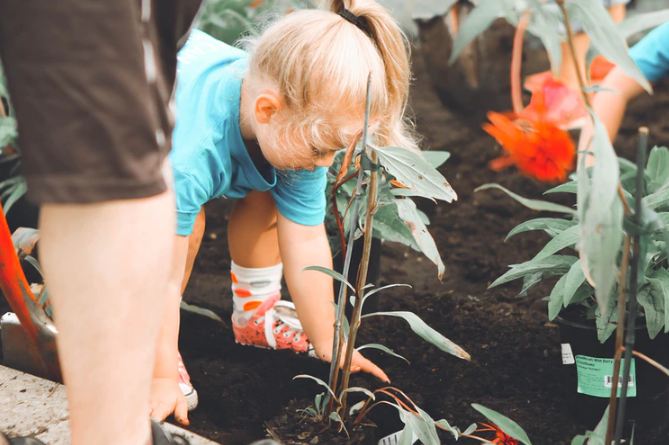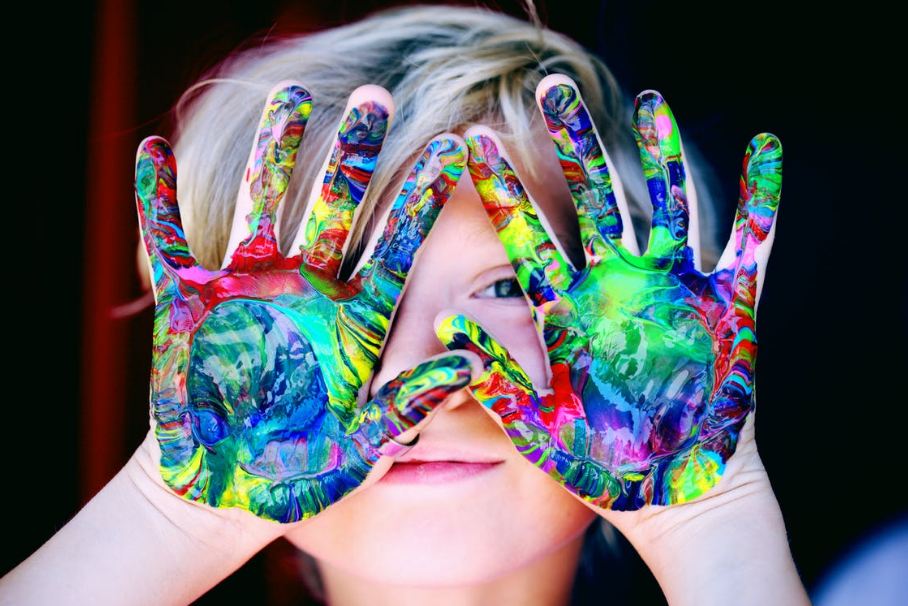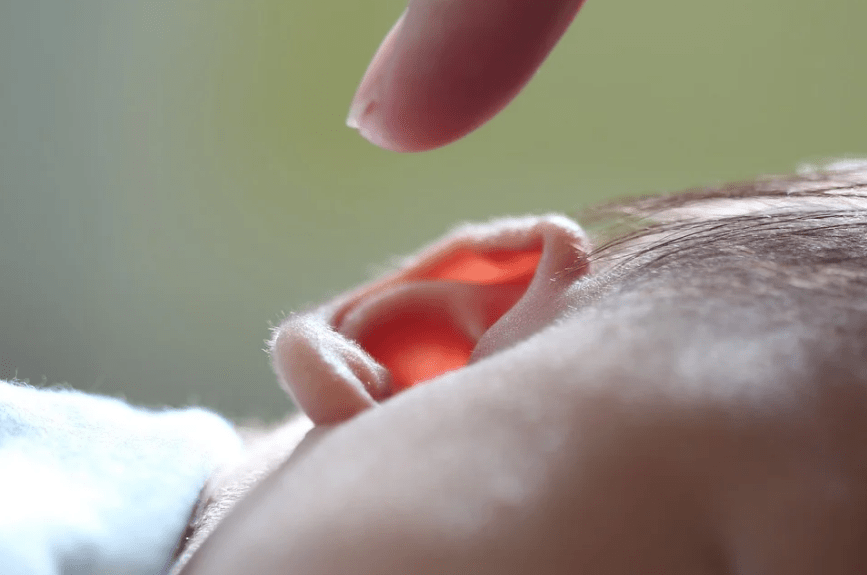10 Creative Playdough Activities for Kids

Always on the lookout for ways to keep your child engaged and learning? Imagine transforming a simple playdough session into an imaginative adventure or a rich learning opportunity. Whether your child is crafting rainbow snakes, running a pretend pizza parlour, or hosting a teddy bears' picnic, these activities are designed to enhance fine motor skills and cognitive development. Curious about how a playdough maze can improve focus or why nature-inspired playdough is great for sensory discovery? Explore these creative activities that promise both fun and educational value.
Pizza Parlour
When you engage in the Pizza Parlour playdough activity, your children will enhance their reading, counting, and understanding of quantities through imaginative pizza-making scenarios. Crafting playdough pizzas offers a wonderful opportunity for kids to participate in pretend play while also engaging in valuable learning exercises. They'll develop fine motor skills by rolling out the dough, cutting toppings, and arranging them on their pizza creations.
In this activity, children assume roles such as chefs, customers, and servers, fostering social interaction and creativity. By simulating a pizza restaurant, they learn to communicate, collaborate, and share responsibilities. Math concepts become tangible as kids divide and count toppings, reinforcing their understanding of fractions and addition. For example, they might add a specific number of pepperoni slices or divide a pizza into equal parts, making abstract ideas concrete and enjoyable.
Additionally, the Pizza Parlour playdough activity introduces shapes, colors, and textures, creating a multisensory learning experience. Children will explore different forms and hues, enhancing their cognitive skills and sensory awareness. This activity seamlessly blends play and learning, offering an enjoyable and educational way to spend time.
Rainbow Snakes
During the Rainbow Snakes activity, children will enhance their color recognition and fine motor skills by rolling out vibrant strips of playdough and twisting them together. This hands-on exercise provides an excellent opportunity for sensory play, allowing kids to explore the various textures and flexibility of the playdough.
Start by providing a selection of colorful playdough. Guide the children to roll each color into long, thin strips. This simple action helps develop fine motor skills as they manipulate the dough with their fingers and hands. Once they have their colorful strips, encourage them to twist two or more together to form a rainbow snake.
Throughout this activity, children will practice naming and identifying different colors, thereby improving their color recognition skills. Mixing and matching various colors also promotes pattern discovery, fostering creativity and imagination.
Rainbow Snakes is not just an entertaining activity; it's an educational tool that seamlessly combines play with learning. Children will enjoy creating unique, vibrant snakes while developing essential skills.
Spiky Hedgehogs

After making vibrant Rainbow Snakes, kids can now enjoy crafting Spiky Hedgehogs by inserting toothpicks or craft sticks into playdough balls. This activity is excellent for developing fine motor skills and enhancing hand-eye coordination. By pinching and pressing the toothpicks or craft sticks into the playdough, children work on their pincer grasp, essential for tasks like writing and buttoning clothes.
The Spiky Hedgehogs activity also encourages sensory exploration. The soft texture of the playdough combined with the rigid toothpicks provides a unique tactile experience. Children will enjoy feeling the different materials and experimenting with various designs, boosting their creativity.
As they create their hedgehogs, children strengthen their small hand muscles, making this both a fun and functional exercise. Watching their hedgehogs take shape is rewarding and encourages them to think about design and structure. So, gather some playdough and toothpicks or craft sticks, and prepare for a delightful, hands-on adventure in making Spiky Hedgehogs!
Five Little Ducks
Engage your child in a fun and educational activity with the Five Little Ducks playdough exercise. This hands-on activity helps them practice counting and number recognition while boosting their math skills through playful subtraction. By molding each duck, they can also enjoy interactive storytelling, blending creativity with learning. This activity makes education enjoyable and effective for young children.
Counting and Number Recognition
The Five Little Ducks playdough activity is a fantastic way to teach kids counting and number recognition through a beloved children's song. This activity not only makes learning fun but also enhances fine motor skills and creativity.
Here's how to bring the activity to life:
- Craft Five Ducks: Have the children create five little ducks using playdough, allowing them to shape the ducks any way they like to encourage creativity.
- Sing the Song: Sing the "Five Little Ducks" song together. Point to each duck as you sing to reinforce counting.
- Remove Ducks: Each time a duck swims away in the song, have the children remove one duck. This visual and tactile method aids in number recognition.
- Count Together: After the song, count the remaining ducks together to reinforce the numbers.
This engaging activity transforms math into a fun, hands-on experience that kids will love, while reinforcing fundamental counting and number recognition skills.
Interactive Storytelling Fun
Immerse your children in interactive storytelling with playdough by bringing the classic nursery rhyme 'Five Little Ducks' to life. This engaging activity can be introduced at home or in the classroom to promote creativity and fine motor skills.
Children mold their own duck characters out of playdough, creating a hands-on experience that enhances their ability to count, sequence events, and explore different emotions. As they make each duck 'swim' away and return, you'll see their faces light up with joy.
This activity supports language development, imaginative play, and problem-solving skills. Encouraging children to interact and collaborate while retelling the story builds social interaction and cognitive abilities. They will delight in the sensory experience of shaping playdough characters and improve their narrative skills. Incorporate this fun and educational activity into your routine to help kids explore their storytelling abilities while enjoying the sensory and creative benefits of playdough.
Enhancing Math Skills
The 'Five Little Ducks' playdough activity is an engaging and educational way to make math fun for children. This interactive exercise helps young learners practice essential math skills such as counting, subtraction, and number recognition. Follow these steps to set up the activity:
- Mold Duck Shapes: Guide the kids in shaping five little ducks from playdough, which also enhances their fine motor skills.
- Sing the Song: While singing the 'Five Little Ducks' song, encourage the children to use their playdough ducks to act out the story.
- Subtract Ducks: Each time a duck 'swims away' in the song, ask the kids to remove one duck, helping them grasp subtraction concepts.
- Count Remaining Ducks: After each verse, count the remaining ducks together to reinforce number recognition and basic math operations.
This activity not only makes math tangible but also fosters problem-solving abilities. Children engage in hands-on play while grasping mathematical concepts, turning abstract ideas into something they can see and touch. Using playdough in this manner effectively supports early math skills development in an enjoyable and interactive way.
Teddy Bears Picnic
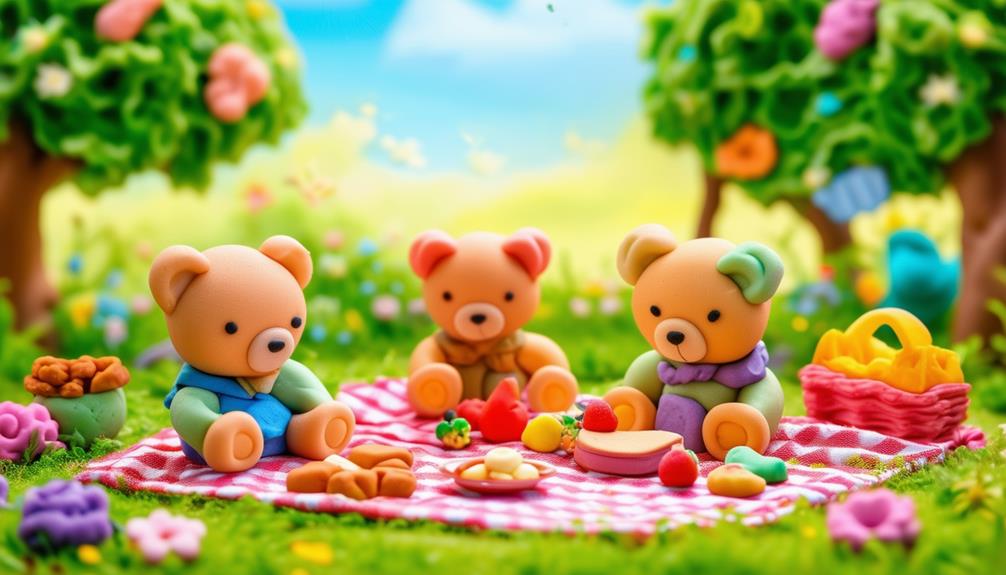
Kids often adore the Teddy Bears Picnic playdough activity because it strengthens their small hand muscles and attention span while sparking creativity. This engaging activity allows children to participate in sensory and imaginative play. They'll enjoy molding and shaping playdough to create a delightful picnic scene, complete with miniature foods and accessories. As they design and decorate, they're not only having fun but also sharpening their fine motor skills.
Moreover, the Teddy Bears Picnic is an excellent way to introduce counting skills. Challenge your child to set up the picnic with a specific number of items for each teddy bear guest. For instance, ask them to make five sandwiches or three cookies. This makes the activity educational and interactive.
Here's a useful table to visualize some creative ideas:
| Item | Number of Items | Description |
|---|---|---|
| Sandwiches | 5 | Shaping playdough into tiny squares |
| Cookies | 3 | Rolling and flattening dough circles |
| Cups of Juice | 4 | Forming small cups with playdough |
| Fruit (e.g., apples) | 6 | Crafting small round fruits |
This playful picnic nurtures storytelling and role-playing, enabling children to immerse themselves in pretend play with their teddy bears. It's a perfect blend of fun and learning!
Pirate Treasure Hunt
After a delightful Teddy Bears Picnic, you can ignite your child's imagination with a thrilling Pirate Treasure Quest using playdough. This engaging activity not only entertains but also promotes sensory exploration, fine motor skills, and imaginative play.
To get started, gather small items like beads, coins, or miniature toys to hide within mounds of playdough. Your child will then excavate and sculpt their way through the playdough to reveal these hidden treasures.
Here's a step-by-step guide to creating your own Pirate Treasure Quest:
- Prepare the playdough: Use or purchase various colors of playdough to add excitement. Hide small gems in each mound, ensuring they are well-concealed.
- Set the scene: Create a pirate map and place the playdough mounds around the 'island' (your living room) as marked treasure spots.
- Equip your pirate: Provide your child with tools like small plastic knives or sculpting tools to assist in digging through the playdough.
- Start the quest: Let your child follow the map, digging and uncovering treasures along the way.
This activity encourages problem-solving skills and provides an enjoyable way for your child to engage in creative play and develop cognitive abilities.
Building Creations
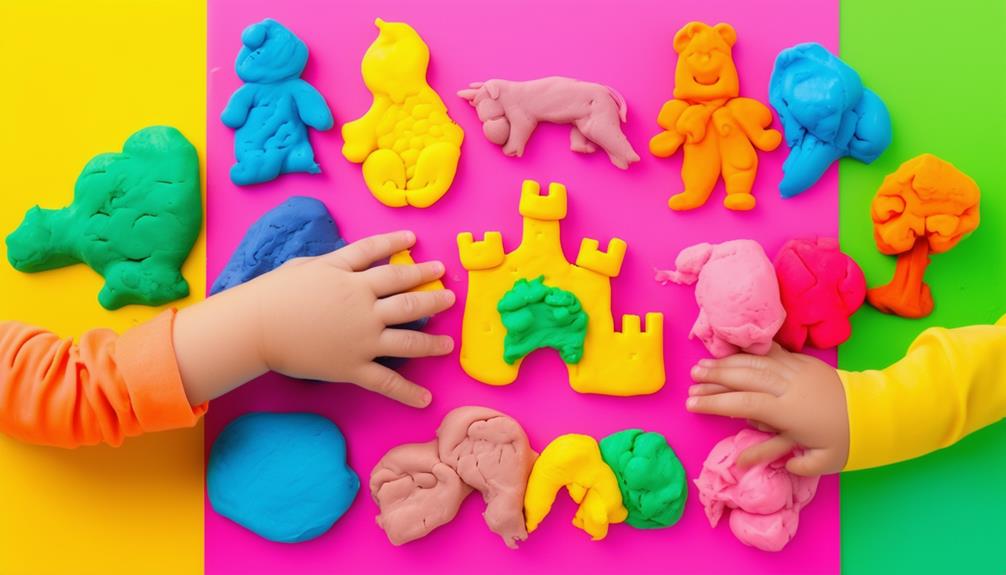
Building creations with playdough unlocks the potential for imaginative play and collaborative projects. Encourage your child to experiment with various shapes and sizes, which nurtures creativity and problem-solving skills. Collaborating on these projects can also enhance their teamwork and communication abilities.
Imaginative Play Structures
Building imaginative play structures with playdough sparks creativity and enhances problem-solving skills in children. When kids engage in building with playdough, they're participating in a rich, hands-on learning experience. They can create a variety of imaginative structures, such as:
- Houses: Encourage them to craft homes complete with tiny furniture and gardens.
- Castles: Let their creativity soar as they construct grand castles with towers and moats.
- Vehicles: They can design anything from simple cars to intricate airplanes.
- Fantasy Worlds: Inspire them to build entire scenes from their favorite stories or dreams.
Experimenting with different shapes, sizes, and designs helps children refine their fine motor skills and hand-eye coordination. The act of molding and shaping the playdough requires precise movements, which strengthen their fingers and hands.
Moreover, imaginative play structures encourage storytelling and role-playing, allowing kids to immerse themselves in interactive play. They might pretend to be royalty living in the castle, a family in the house, or adventurers in their fantasy world. Through these activities, children learn to think creatively and solve problems, laying a solid foundation for future learning. So, grab some playdough and witness your child's imagination unfold!
Collaborative Building Projects
Collaborative building projects using playdough are excellent for fostering teamwork and shared creativity among children. Engaging in these activities helps kids learn to communicate and solve problems collectively. Constructing intricate structures together not only stimulates their imagination but also enhances their critical thinking skills.
One engaging playdough activity is challenging children to build a small village. They can distribute roles, with some crafting houses while others make trees, roads, and small figures. This collaborative effort encourages sharing ideas and working towards a common goal, essential for developing robust social skills.
Here is a table that illustrates potential collaborative projects and the skills they develop:
| Activity | Skills Developed |
|---|---|
| Building a Playdough City | Teamwork, creativity |
| Creating a Zoo | Communication, problem-solving |
| Designing a Park | Imagination, critical thinking |
In these collaborative building projects, children not only create fantastic structures but also experience a sense of accomplishment. Observing their combined efforts come to life teaches them the value of cooperation and shared creativity. Playdough activities offer endless possibilities for fun and learning, making them an excellent choice for group play.
Playdough Maze
Creating a playdough maze on a flat surface offers children a fun, hands-on activity that enhances problem-solving and fine motor skills. This activity encourages creative use of playdough while fostering essential cognitive abilities. Playdough activities, such as building mazes, provide a balanced mix of enjoyment and educational benefits for young children.
To make a playdough maze, follow these steps:
- Flatten the playdough: Roll out the playdough into a large, smooth surface.
- Create the maze walls: Use additional playdough to form walls and pathways on the flattened base.
- Add obstacles: Place small figurines or toys as barriers within the maze.
- Navigate the maze: Encourage children to guide a small toy or their fingers through the maze.
Nature Playdough

After mastering the playdough maze, you can enrich your child's sensory exploration with nature playdough activities. This creative play incorporates natural elements like herbs, seeds, and flowers, offering a unique way for children to connect with their environment. Imagine the delight on your child's face as they press lavender buds into the dough or sprinkle in sunflower seeds.
Nature playdough provides a calming sensory experience through soothing textures, scents, and colors of organic elements. It's not just fun; it's educational. By using natural components, your child gains a better understanding of the natural world's properties in an interactive way. They'll learn about different textures, like the roughness of seeds or the softness of petals, and explore diverse scents, from mint leaves to rosemary sprigs.
These activities also foster creativity and imagination. Your child can create miniature gardens, textured landscapes, or even pretend food items. The possibilities are endless, making each play session an opportunity for hands-on learning. Gather some organic ingredients and let your child's sensory exploration flourish with nature playdough.
Sensory Exploration
Engaging in sensory exploration with playdough offers a rich, multi-sensory experience for children, enhancing their sensory processing and creativity.
Sensory exploration with playdough includes:
- Tactile Exploration: Encourage your child to squish, roll, and mold the playdough. This hands-on activity helps them understand different textures while building fine motor skills.
- Visual Stimulation: Utilize playdough in various vibrant colors. Observing how the colors blend and change as they manipulate the dough can be both mesmerizing and educational.
- Aromatic Scents: Introduce safe, child-friendly scents like lavender or vanilla to the playdough. These scents enrich the sensory experience and can have calming effects.
- Creative Expression: Allow your child the freedom to create whatever they imagine, fostering creativity and self-expression.
These playdough activities help children regulate emotions, improve focus, and develop cognitive skills. They also promote relaxation and stress relief, supporting overall well-being.


